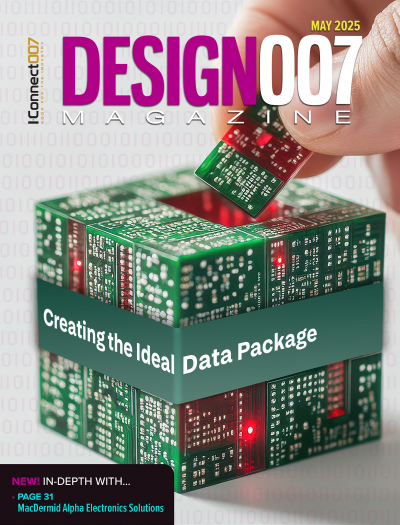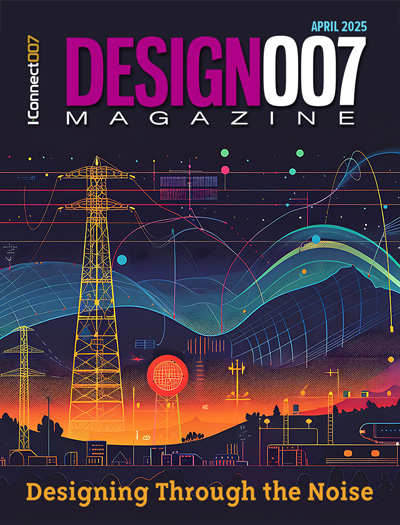-

-
News
News Highlights
- Books
Featured Books
- design007 Magazine
Latest Issues
Current Issue
All About That Route
Most designers favor manual routing, but today's interactive autorouters may be changing designers' minds by allowing users more direct control. In this issue, our expert contributors discuss a variety of manual and autorouting strategies.

Creating the Ideal Data Package
Why is it so difficult to create the ideal data package? Many of these simple errors can be alleviated by paying attention to detail—and knowing what issues to look out for. So, this month, our experts weigh in on the best practices for creating the ideal design data package for your design.

Designing Through the Noise
Our experts discuss the constantly evolving world of RF design, including the many tradeoffs, material considerations, and design tips and techniques that designers and design engineers need to know to succeed in this high-frequency realm.
- Articles
- Columns
- Links
- Media kit
||| MENU - design007 Magazine
IPC APEX EXPO 2025 Review: The New Normal Looks Like the Old Normal
April 16, 2025 | Nolan Johnson, SMT007 MagazineEstimated reading time: 5 minutes
At IPC APEX EXPO, my days are filled with either talking or listening from sunup to sundown. I get to answer questions of some of the brightest minds in the business, while also listening and synthesizing what they’re sharing with me about the current and future state of the industry. Here are five observations based on the conversations.
- The industry is optimistic. Even in the face of uncertainty, buyers and vendors are moving forward with their plans. As one industry insider said, “If they have a strategic plan at all, they’re still executing on it.” The sentiment seems to be that the upward trend might be shifted by current changes in economic policy coming out of the U.S, but it will not be squelched by it. Naturally, the trade in equipment seemed brisk on the show floor.
- The EMS Leadership Summit is improving in value and insight. I’ve had the pleasure of attending several of these summits, and each year the agenda gets better. Mark Wolfe, Tracy Riggan, and the rest of the planning committee dial in the program with every iteration. If the objective of the summit is to bring EMS industry leadership together to network, build better working relationships, and to share the latest industry information, then the summit team raised the bar again this year. I highly recommend attending next year’s daylong event.
- The developments in adjacent tech sectors will change our manufacturing techniques. It has always been the case that adjacent industries—semiconductor manufacturing for example—influence our industry. New component packages are an obvious example. Devan Iyer, IPC chief strategist for advanced packaging, Dr. Ahmed Bahai, chief technology officer at Texas Instruments and one of the keynote speakers, discussed with me at length about the new developments in packaging. The themes in the conversation suggest not a trickle-down but rather a cascading chain of events that will change the components we will handle. Another key development is shrinking feature sizes on the PCB, for which some of the older semiconductor manufacturing technologies come increasingly into play—for example, interposers. Consequently, some of our PCB fabs are starting to look like the early semiconductor fabs—and they should. We’re fabricating in those same feature sizes on the board nowadays that used to be on the chip. New materials require new methods, while some require minor tweaks, and others require the installation of entire lines. New software tools for process control, sensing, tracking, inventory management, scheduling, and more, continue to move us deeper into the reality of Industry 4.0. Which leads me to AI.
- Artificial intelligence is here to stay and soon enough will earn its keep. I discount generative AI, however. It’s getting all the hype in the mainstream and will likely follow the traditional hype curve. Sure, it has a place, but all we have to do is look at Ben Rachinger’s award winning paper from this year’s conference to see that AOI data sets not only can be shared between multiple companies through a federated library to build a more powerful large language model, but that the data can also be stored in tokens, protecting the proprietary nature of the source data. The unexpected insights coming from AI LLM implementations which are properly used is nothing less than mind-boggling. In focused industrial applications, predictive analysis based on seeing patterns in past data so subtle that humans cannot identify them, will be disruptive. Disruptive in a good way.
- Regional diversification seems to be unstoppable. Sure, opinions differ on whether regional development is good for the industry, but it seems like those who are building up infrastructure are bullish, while those losing market share are bearish. India, SE Asia, and Mexico continue to build out. While it’s true that much of the investment in these three regions was originally to support automotive and EVs, the available capacity outside China seems to be attractive to OEMs looking to reshore.
Another sign of regional vibrancy is the increased involvement of Japan and SE Asia in IPC standards work, etc. Sydney Xiao, IPC president of North Asia, highlights this trend in her Real Time with… interview.
Thirty years ago, the PCB portion of the electronics industry was a thriving network of businesses: Many family-owned or similarly small serving a local/regional customer base. This was when the OEMs took a much more active role in moving their designs into fabrication and manufacture. A key part of that highly resilient supply chain was that OEMs of a certain size would build their own fab and EMS facilities, keeping manufacturing in-house and customized to their products. But then, on a global scale, we threw up obstacles and diverted most of the business to one central region.
In the western United States, we’ve been removing dams from our riverways. Built originally for various well-intentioned but obsolete purposes, these dams persist in disrupting an ecosystem while no longer providing any benefit in return. It is a biologist’s dream to study how a river ecosystem rebounds once the dam is demolished. While it’s no surprise that the original ecosystem returns; what is surprising is the rapidity and the robustness with which the regional diversity recovers. Rivers for which the dam had wiped the native salmon population for a hundred years, now have salmon returning to spawn as little as three years later1.
Like the rivers, our regional diversity is returning. As Chris Mitchell, IPC vice president of global government relations, said in his interview with I-Connect007, the world wholeheartedly embraced free trade after the fall of the Berlin wall. It can be argued that we overdid it, resulting in optimizing the resilience out of our supply chains, diverting too much economic flow away from its natural course, as it were. Chris suggests that the pendulum is swinging back to encourage more regional competitiveness. Alison James, IPC senior director for Europe, has been speaking with us about IPC Europe’s work with the European Union’s electronics competitive compass. After hearing their remarks, I could see the parallels to the dam removal projects: We need to clear out the barriers, obstacles and diversions, while also paying attention to sustainability, in order to re-establish a thriving ecosystem. It was my take-away that the competitive compass work seems intent to remove key strategic economic dams so that European manufacturing can once again flow.
There is no doubt, this is an exciting time to be in electronics manufacturing. Virtually every aspect of our industry is moving solidly (finally) into the 21st century. It’s about time.
References
1. I asked Grok to fact check this claim, only to find out that river biologists reported migratory fish returning in just weeks or months if the conditions were right.
This article originally appeared in the April 2025 issue of SMT007 Magazine.
Suggested Items
I-Connect007 Editor’s Choice: Five Must-Reads for the Week
06/27/2025 | Nolan Johnson, I-Connect007While news outside our industry keeps our attention occupied, the big news inside the industry is the rechristening of IPC as the Global Electronics Association. My must-reads begins with Marcy LaRont’s exclusive and informative interview with Dr. John Mitchell, president and CEO of the Global Electronics Association. For designers, have we finally reached the point in time where autorouters will fulfill their potential?
Reflections and Priorities: An Update to I-Connect007 Readers
06/24/2025 | Marcy LaRont, I-Connect007The electronics and manufacturing industry is evolving rapidly—with new technologies, deeper global connections, and a growing drive toward sustainability. To reflect these changes and our place in this dynamic space, we’re refreshing our brand.
The Knowledge Base: Building the Workforce of Tomorrow With EMAC
06/24/2025 | Mike Konrad -- Column: The Knowledge BaseAs the electronics manufacturing industry races to meet rising global demand and technological complexity, the need for a highly skilled, future-ready workforce has never been greater. At the forefront of addressing this challenge is The Electronics Manufacturing & Assembly Collaborative (EMAC)—a national initiative dedicated to strengthening the talent pipeline through strategic collaboration with SMTA, education, and government stakeholders.
IPC Rebrands as Global Electronics Association: Interview With Dr. John W. Mitchell
06/22/2025 | Marcy LaRont, I-Connect007Today, following a major announcement, IPC is embracing the rapid advancement of technology with a bold decision to change its name to the Global Electronics Association. This name more accurately reflects the full breadth of its work and the modern realities of electronics manufacturing. In this exclusive interview, Global Electronics Association President and CEO Dr. John W. Mitchell shares the story behind the rebrand: Why now, what it means for the industry, and how it aligns with the organization’s mission.
Global Electronics Association Debuts; New Name Elevates IPC’s 70-Year Legacy as Voice of $6 Trillion Electronics Industry
06/25/2025 | Global Electronics AssociationToday begins a new chapter for IPC as it officially becomes the Global Electronics Association, reflecting its role as the voice of the electronics industry. Guided by the vision of “Better electronics for a better world,” the Global Electronics Association (electronics.org) is dedicated to enhancing supply chain resilience and promoting accelerated growth through engagement with more than 3,000 member companies, thousands of partners, and dozens of governments across the globe.


